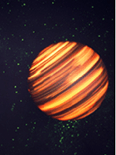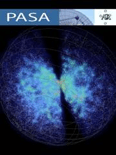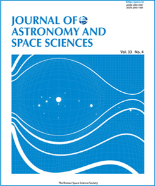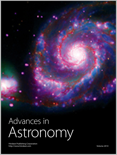
Contributions of the Astronomical Observatory Skalnate Pleso
metrics 2024
Unlocking Celestial Secrets: Your Access to Groundbreaking Research
Introduction
Contributions of the Astronomical Observatory Skalnate Pleso, published by the Slovak Academy of Sciences Astronomical Institute, serves as a vital platform for the dissemination of research in the realm of Astronomy and Astrophysics. With its ISSN number 1335-1842 and E-ISSN 1336-0337, this esteemed journal aims to foster scientific discourse and innovation among researchers, professionals, and students alike. Although it currently holds a Q4 quartile ranking in its field as of 2023, the journal encourages contributions that enhance our understanding of universe dynamics and celestial phenomena through rigorous research methodologies. Spanning from its inaugural year in 2007 to the projected continuation through 2024, it integrates local insights from Slovakia with broader international endeavors in astronomy. The journal promotes an open-access approach, providing scholars unrestricted access to valuable findings and discussions, thereby advancing the boundaries of astronomical knowledge.
Metrics 2024
 0.20
0.20 0.40
0.40 0.30
0.30 13
13Metrics History
Rank 2024
Scopus
IF (Web Of Science)
JCI (Web Of Science)
Quartile History
Similar Journals

Annual Review of Astronomy and Astrophysics
Unveiling the wonders of space and time.Annual Review of Astronomy and Astrophysics is a premier academic journal published by Annual Reviews, dedicated to advancing knowledge in the fields of astronomy and astrophysics. With an impressive impact factor and recognition as a Q1 journal in both Astronomy and Astrophysics, as well as Space and Planetary Science, it stands amongst the top-ranked publications globally with Scopus Rankings placing it in the 99th percentile. The journal spans over three decades of scholarly contributions from 1990 to 2023, creating a rich repository of knowledge for researchers, professionals, and students alike. Although it does not offer Open Access, its rigorous peer-review process ensures the utmost quality and relevance of published articles, making it an essential resource for anyone seeking to stay at the forefront of developments in the cosmos. With its dedication to covering the forefront of research and essential reviews, the Annual Review of Astronomy and Astrophysics is vital for those engaged in exploring the universe and its phenomena.

PUBLICATIONS OF THE ASTRONOMICAL SOCIETY OF AUSTRALIA
Exploring the Frontiers of Astronomy and Beyond.Publications of the Astronomical Society of Australia, published by Cambridge University Press, stands as a distinguished platform for advancing knowledge in the realms of Astronomy, Astrophysics, Space, and Planetary Science. Hemmed in the United Kingdom, this journal is recognized for its outstanding contributions, reflected in its status as a Q1 journal in both Astronomy and Astrophysics, along with Space and Planetary Science categories as of 2023. With a solid impact factor, it ranks impressively at #23 within its Scopus category, firmly placing it in the competitive 75th percentile. This publication facilitates open discourse and innovative research from its inception in 1996 to the present year of 2024, providing an essential resource for researchers, professionals, and students eager to deepen their understanding of cosmic phenomena. By embracing rigorous peer-review standards and a commitment to scholarly excellence, the journal not only contributes to the scientific community but also fosters the next generation of astronomical research.

Journal of Astronomy and Space Sciences
Pioneering Insights into the Mysteries of Space.The Journal of Astronomy and Space Sciences, published by the Korean Space Science Society, is a premier open-access platform dedicated to advancing the fields of astronomy, astrophysics, and space sciences. Established in 1984, the journal has been instrumental in disseminating high-quality research findings, fostering collaboration among scientists globally, and providing insights into the dynamics of our universe. With an ISSN of 2093-5587 and an E-ISSN of 2093-1409, the journal has gained notable recognition, currently ranking in the Q3 quartile in Earth and Planetary Sciences and Physics and Astronomy as of 2023. Although the journal's H-Index is currently unspecified, its commitment to rigorous peer-review processes and open-access availability ensures that groundbreaking research is accessible to a wide audience. Based in Seoul, South Korea, the journal is poised to continue supporting innovative research through 2024 and beyond. Researchers, professionals, and students alike will find valuable resources and opportunities within its pages, further establishing this journal as a crucial resource in the exploration of the cosmos.

EXPERIMENTAL ASTRONOMY
Charting New Frontiers in Space and Planetary ResearchEXPERIMENTAL ASTRONOMY, published by Springer, stands as a pivotal journal in the fields of Astronomy and Astrophysics as well as Space and Planetary Science. With an impressive Scopus ranking and a Q2 category as of 2023, the journal is recognized for its impactful contributions to experimental techniques and observations in astronomy. Covering a broad spectrum of topics from cosmic phenomena to planetary exploration, it serves as a vital platform for researchers, professionals, and students to disseminate and discuss innovative ideas and findings. The journal has evolved through various convergence years since its inception in 1989 and continues to thrive, fostering an environment for academic pursuit and collaboration. Though not an open-access journal, its rigorous peer-review process ensures high-quality publications that are essential for advancing the scientific community's understanding of the universe.

SOLAR SYSTEM RESEARCH
Connecting Researchers to the Wonders of the UniverseSOLAR SYSTEM RESEARCH, published by Pleides Publishing Inc, offers a comprehensive platform for the exploration and dissemination of scientific knowledge in the fields of Astronomy, Astrophysics, and Space and Planetary Science. With its origins tracing back to 1969, this journal provides a vital resource for researchers and professionals seeking to deepen their understanding of the solar system's complexities, including planetary formation, extraterrestrial geology, and the dynamics of celestial bodies. Although categorized in the Q4 quartile for both relevant disciplines, SOLAR SYSTEM RESEARCH remains committed to publishing high-quality research that contributes to advancing contemporary scientific discourse. Dedicated to fostering collaboration and innovation, the journal is indexed in Scopus and adheres to rigorous academic standards, making it an essential resource for students and professionals alike pursuing the latest developments in solar system studies.

PUBLICATIONS OF THE ASTRONOMICAL SOCIETY OF JAPAN
Fostering global dialogue in astronomy and astrophysics.Publications of the Astronomical Society of Japan is a prestigious, peer-reviewed journal dedicated to advancing the field of astronomy and astrophysics. Published by Oxford University Press, this journal provides a platform for high-quality research, fostering scientific communication among both established researchers and emerging scholars. With an ISSN of 0004-6264 and E-ISSN 2053-051X, it is recognized for its significant impact in its field, boasting a Q2 ranking in both Astronomy and Astrophysics and Space and Planetary Science as of 2023. The journal seeks to bridge traditional and innovative approaches to expand understanding of celestial phenomena, making it an essential resource for professionals, students, and researchers alike. Researchers can access a wealth of cutting-edge studies spanning theoretical and observational aspects of astronomy from its inception in 1996 to the present day. Although the journal operates under a traditional access model, it remains a respected forum for pivotal discoveries and discussions within the global astronomical community.

Advances in Astronomy
Pioneering Research in Astronomy and Astrophysics.Advances in Astronomy is a prestigious open-access journal published by HINDAWI LTD, dedicated to the field of astronomy and astrophysics. Established in 2008, the journal aims to disseminate significant research findings and advancements in the understanding of celestial phenomena, planetary sciences, and the intricate workings of the universe. With an impact factor that reflects its relevance in the scholarly community, Advances in Astronomy holds a commendable rank of Q3 in both Astronomy and Astrophysics as well as Space and Planetary Science categories, indicating its importance within these fields. The journal also showcases a commitment to open-access publishing, ensuring that research is readily available to both the scientific community and the public. Researchers, professionals, and students alike are encouraged to contribute to this dynamic forum to share knowledge and foster collaboration in exploring the wonders of the cosmos.

Advances in Astronomy and Space Physics
Navigating the Depths of Astronomy and Space Physics.Advances in Astronomy and Space Physics is an esteemed journal dedicated to the exploration and dissemination of research in the expansive fields of astronomy and space science. Published by Taras Shevchenko National University of Kyiv, this journal provides a platform for researchers, professionals, and students to share groundbreaking studies and innovations. With an ISSN of 2227-1481, it covers a wide range of subjects including astrophysics, planetary sciences, and space exploration technologies, thereby fostering interdisciplinary collaboration. Although not an Open Access journal, it maintains a commitment to high-quality, peer-reviewed content that contributes significantly to the advancement of scientific knowledge. The journal's mission is to promote sustainable practices in space research while also exploring the implications of discoveries on Earth and beyond. By maintaining rigorous publication standards, Advances in Astronomy and Space Physics aims to serve as a critical resource for those involved in the ever-evolving study of our universe.

Bulgarian Astronomical Journal
Unveiling the Secrets of the StarsThe Bulgarian Astronomical Journal, published by the BULGARIAN ACADEMY OF SCIENCES, INSTITUTE OF ASTRONOMY, serves as a vital platform for the dissemination of research in the field of Astronomy and Astrophysics. With the ISSN 1313-2709 and E-ISSN 1314-5592, this journal has been pivotal in showcasing original studies and advancements in astronomical sciences from 2014 and will continue to do so through 2025. Although categorized in Q4 within the ambit of Astronomy and Astrophysics, it provides essential insights and innovative findings, making significant contributions to the global academic community. Positioned in the lower quartile of Scopus rankings, recognized as #87 out of 90, it offers an opportunity for burgeoning researchers and seasoned professionals alike to engage with emerging ideas and trends in the discipline. While it currently does not feature an open access model, readers and contributors can anticipate a rich exchange of scientific knowledge that fosters collaboration within the astronomy community.

Journal of the Korean Astronomical Society
Charting New Frontiers: The Pulse of Astronomical ResearchWelcome to the Journal of the Korean Astronomical Society, an esteemed publication dedicated to advancing the fields of Astronomy and Astrophysics as well as Space and Planetary Science. Established in 1993 and under the reputable auspices of the Korean Astronomical Society, this journal serves as a vital platform for researchers and scholars from South Korea and around the globe to disseminate innovative findings and critical insights. With a commendable Q2 ranking in Astronomy and Astrophysics and a Q3 ranking in Space and Planetary Science, this journal is positioned among the influential voices in its fields, fostering collaboration and knowledge exchange. The journal's rigorous peer-review process ensures that published works contribute significantly to ongoing discussions and developments in astronomical research. While currently not an open-access journal, it remains accessible to the academic community, encouraging readers to stay abreast of the latest advancements in the sciences that elucidate the universe's complexities. Join us in exploring the cosmos through cutting-edge research and scholarly discussion that propels the field forward.